
AZoBuild spoke to Anssi Lassila from OOPEAA about their Tikkurila Church and Housing project, which was shortlisted for the EU Mies van der Rohe Award for contemporary architecture. The building is an ambitious and multi-faceted residential and community space.
Please could you introduce yourself, your background, and how you came to be involved in architecture?
I was raised in the countryside in a small village in Ostrobothnia, Finland. I don’t come from a family of architects. However, building and creating things has fascinated me ever since my early childhood. The idea of architecture as a means to make buildings for people to create places and spaces for a good life inspired me to apply to architecture school and to pursue studies in architecture.
When I was still a student of architecture, my proposal for a student competition to build a new church with traditional local methods to serve the contemporary needs of the people in Kärsämäki was selected as the winner, and I got a first feel for the work of an architect in practice.
That project turned out to be a foundational experience for me. It gave me an opportunity to learn from the old masters about working with wood and it also taught me that creating a building is always a collaborative effort that involves people with expert knowledge from many fields, as well as a community of users, be it small or large.
The Kärsämäki Church immediately received a lot of attention, both in Finland as well as internationally, and gave me a sense of architecture as something that emerges from the particularities of its local context and yet also has the capacity to reach beyond the local and to speak to a wide audience globally.
The goal of creating buildings for a good life, be it for individual families or for larger communities of an urban scale, continues to be the defining factor and motivator for me in my work as an architect.

Image Credit: Hannu Rytky
The Tikkurila Church and Housing project is a combination of apartments, student housing, and a church. What inspired this project and why choose to create an intersection between these three purposes?
The lot was already previously used by the church and its affiliated offices. However, the use of space was not very efficient, and in the growing community of Tikkurila, there was an urgent need for more housing. To better serve the residents of the increasingly multicultural community, the Vantaa parishes also wanted to offer space for a diversity of activities and a place with a low threshold for people to come together in.
Building a church that is integrated into a block with a diversity of functions was an inspiring challenge to meet and a welcome opportunity to explore various possible ways of giving the church an independent identity while also working well as part of the larger complex of the block. I found it also interesting to have a chance to create an entity in which the public, the semi-public, and the private meet in a balanced way to compose an active and lively neighborhood.
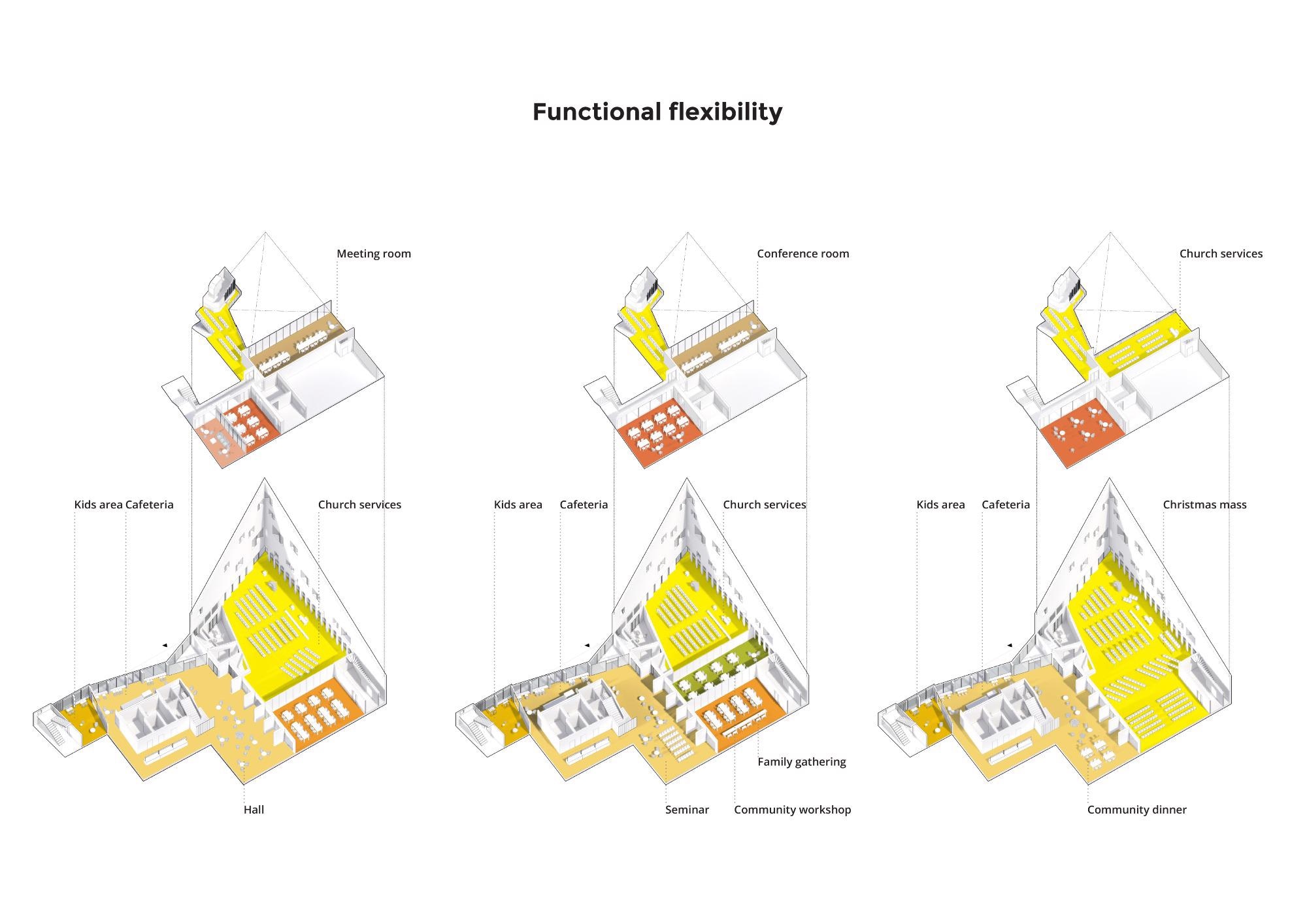
Click to Expand. Image Credit: OOPEAA
Could you please describe the organization of space in this building?
We chose to place the church in the corner of the lot both to make it easily accessible as well as to give it prominence in the main square of Tikkurila, where it is located opposite the town hall. In the corner, the church rises up to 20 meters of height. Extending out from the focal point of the corner and up from the street level, the functions in the block gradually change from the most public ones to increasingly private ones.

Image Credit: OOPEAA
The public character of the church shifts to the semi-public nature of the yard and then to the private spaces of the apartments, creating an interesting dynamic between the different spaces. The height of the church in the corner gets lower where the entrances have been placed to make them inviting and easily approachable.
The café is placed on the side facing the square, and the lobby opens with large windows to the semi-public space of the yard on the back. The yard is shared with the residents of the apartment building, and it can also be entered directly from the street. In this way, the spaces of the church mediate between the public, the semi-public, and the private with large windows opening out to the public life on the street and to the semi-public sphere of the yard.
In the church, the most public functions are located on the ground floor, with spaces for meetings and workshops on the second floor, and offices on the third and fourth floors. The spaces are flexibly adjustable so that they can be used for a variety of different kinds of activities ranging from sacral events to non-sacral concerts and performances of widely different kinds, and they can be divided to facilitate multiple simultaneous activities. At its maximum capacity, the main hall of the church can fit an audience of about 500 people.
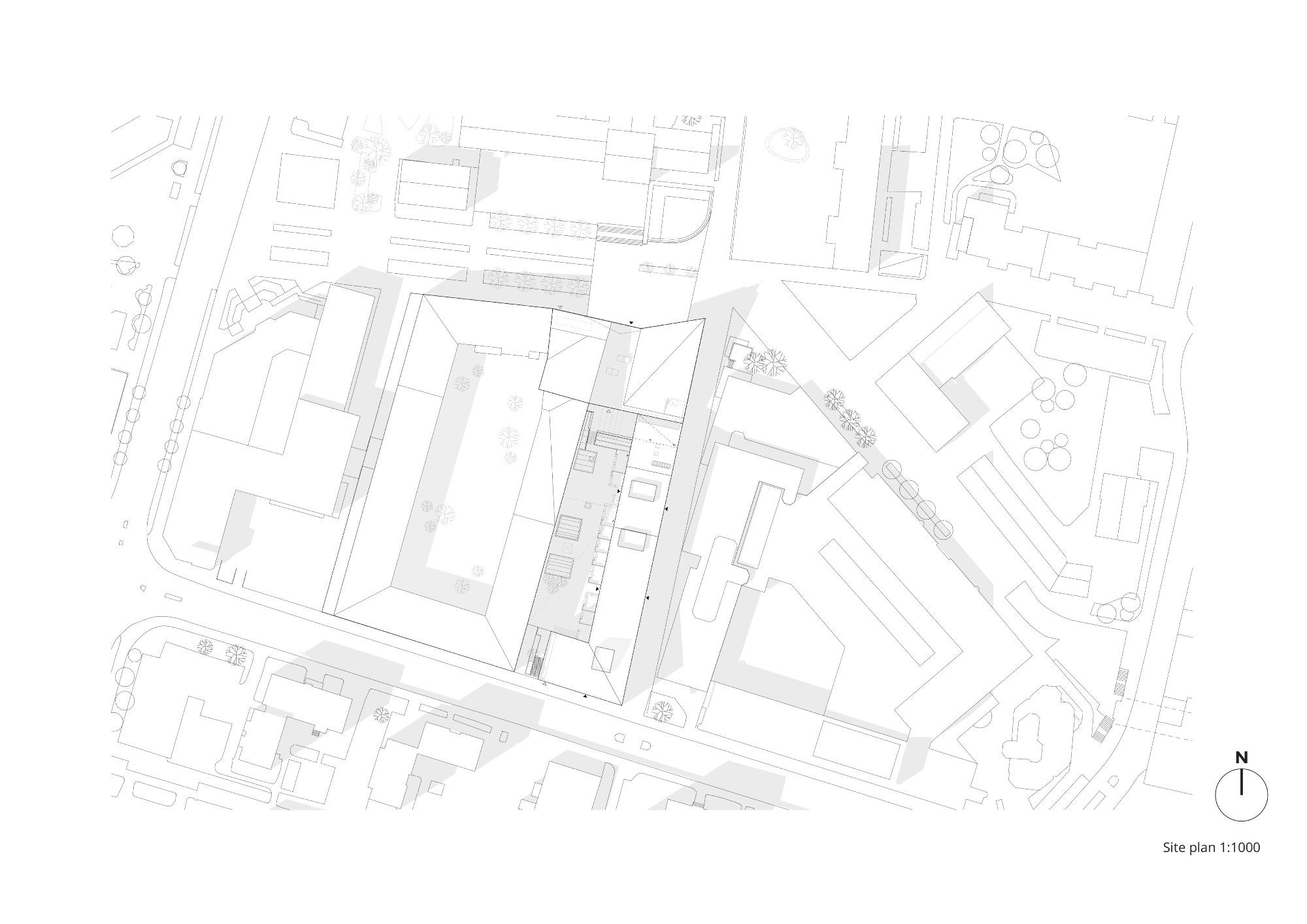
Image Credit: OOPEAA
The same principle is applied in the apartment building with retail spaces and shared spaces including laundry and bike storage for the residents on the ground floor, and more private spaces on the higher floors. On the top floor, there are shared facilities including a sauna and a roof terrace.
Focusing on the Church, what was the motivation behind its sharply sloped façade?
The steeply sloping roofs of the church give it a strong sculptural shape that highlights its role as an identifying landmark for the neighborhood.
It signals its function as one that is different from the rest of the block with a lot of housing. The entrance to the church has been intentionally placed in a lower part of the building to give it scale that makes it easily accessible and inviting. The steeply sloping roofs make it also possible for the church to serve as a kind of mediating element between the scale of the town hall from the 1950s and that of the taller scale of the new housing that is being built in the neighborhood to meet the increasing demand for apartments.
In the interior, the high ceiling in the main church hall reaches up to 15 meters of height, giving it a sense of spaciousness that serves to elevate the feeling of a sacral space or as a space for non-sacral performances. It also makes it possible to create an acoustic solution that can be adjusted for different types of music, voice, and sound.

Image Credit: Marc Goodwin
The café and the kids’ corner, in turn, are placed in the lower part of the church building to create a cozy and relaxed atmosphere. The café and the kids’ corner have large windows facing the square to create a dialogue between the interior and the exterior and to highlight the social and open nature of these spaces.
Could you describe some of the other key design elements throughout the building and the effect that they have?
In addition to placing the church in the corner, highlighting it with the steeply sloping roofs, and giving it a distinctive sculptural form to create a building with a strong character of its own that functions as an identifying landmark for the entire neighborhood, I would say that two other key design elements in the building are the material choices and the way in which windows are carefully placed to allow daylight to work with the materials, bringing out their textural qualities.
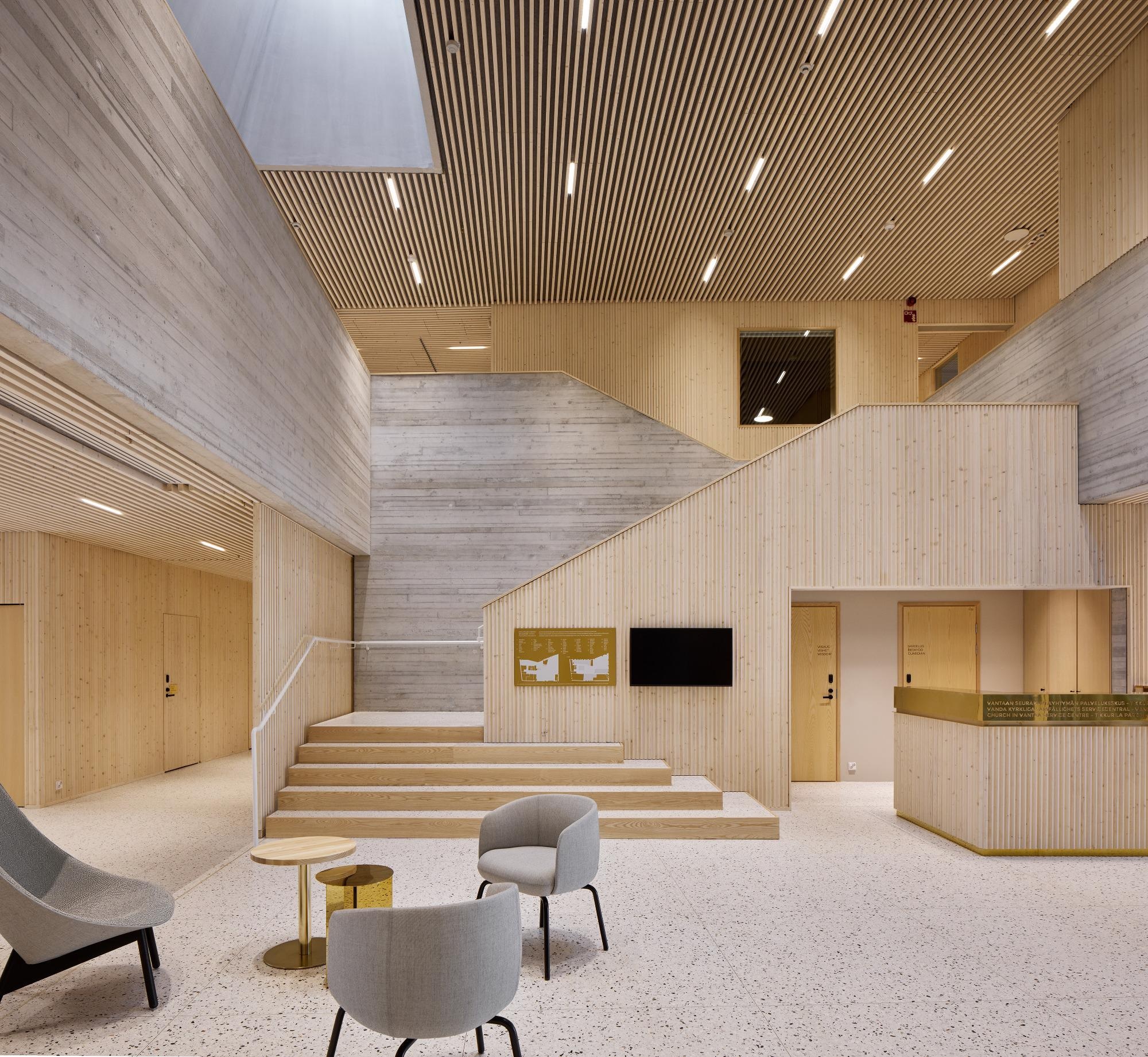
Image Credit: Tuomas Uusheimo
The materials have been chosen to support the goal of creating a building that can last for 200 years. Brick has been used in the exteriors, both in the facades and in roofs in the parts that are visible from the street, to create a building that sets itself in dialogue with the surrounding buildings that are mainly in brick.
To highlight the church in the corner and to give the brick facades a softer character, we chose to use multicolored brick. The brickwork is carefully done and its subtle details give the building a lively feel. Concrete poured in situ is used in the main church hall to create a slightly rough and uneven surface.
The light that is seeping in from the carefully placed windows changes according to the time of the day and the year. It brings out the texture of the concrete, giving it a sense of softness and character. Elsewhere in the interiors of the church building, wood is used to give a sense of warmth to the spaces. All these materials have a sense of honesty to them. Concrete is treated as concrete, brick as brick, and wood as wood. They will all acquire a beautiful patina over time as the building ages.
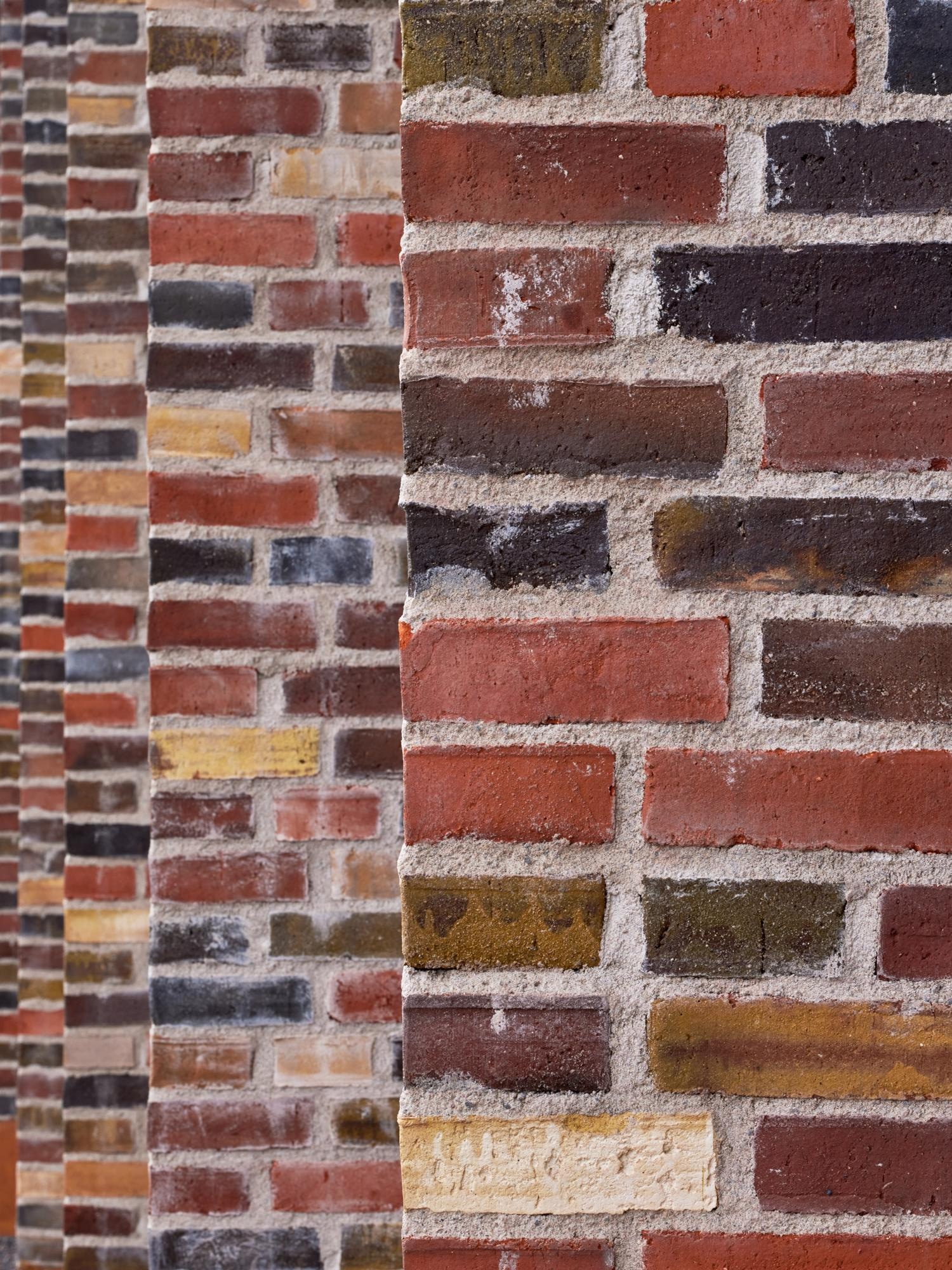
Image Credit: Tuomas Uusheimo
How important is it for architects to consider the needs and experiences of the community when designing a project?
As I mentioned previously, I learned early on when working on the Kärsämäki Church, my first independent work as an architect, that buildings are first and foremost created for a community of users, however small or large it may be. A dialogue with the community of the future users of the building has always been important for me as part of the design process, and it is essential in serving the goal of creating buildings for a better life - the main goal for me in my practice of architecture.
In the case of the Tikkurila Church and Housing, the goal was to create a building that in many ways deviates from the conventional frame of reference. For example, the workspaces are organized to support an entirely new way of working that is different from the one that the employees of the parishes in Tikkurila were used to working in.
Also, the combination of various levels of more or less publicly open and accessible spaces with spaces that are clearly more private in nature was quite unconventional. Further, so was the idea of integrating the church in a block of housing.
The process of design for the Tikkurila Church and Housing included a lot of collaboration with the various groups of the future users of the building, from employees of the Vantaa parishes and the church to the social workers, and from residents in the neighborhood to people who would be using the spaces for performances of various kinds. During the design process, several workshops were held to get input and comments from future users, as well as to hear experts in matters of acoustics and other key aspects of the adjustable multifunctional spaces.
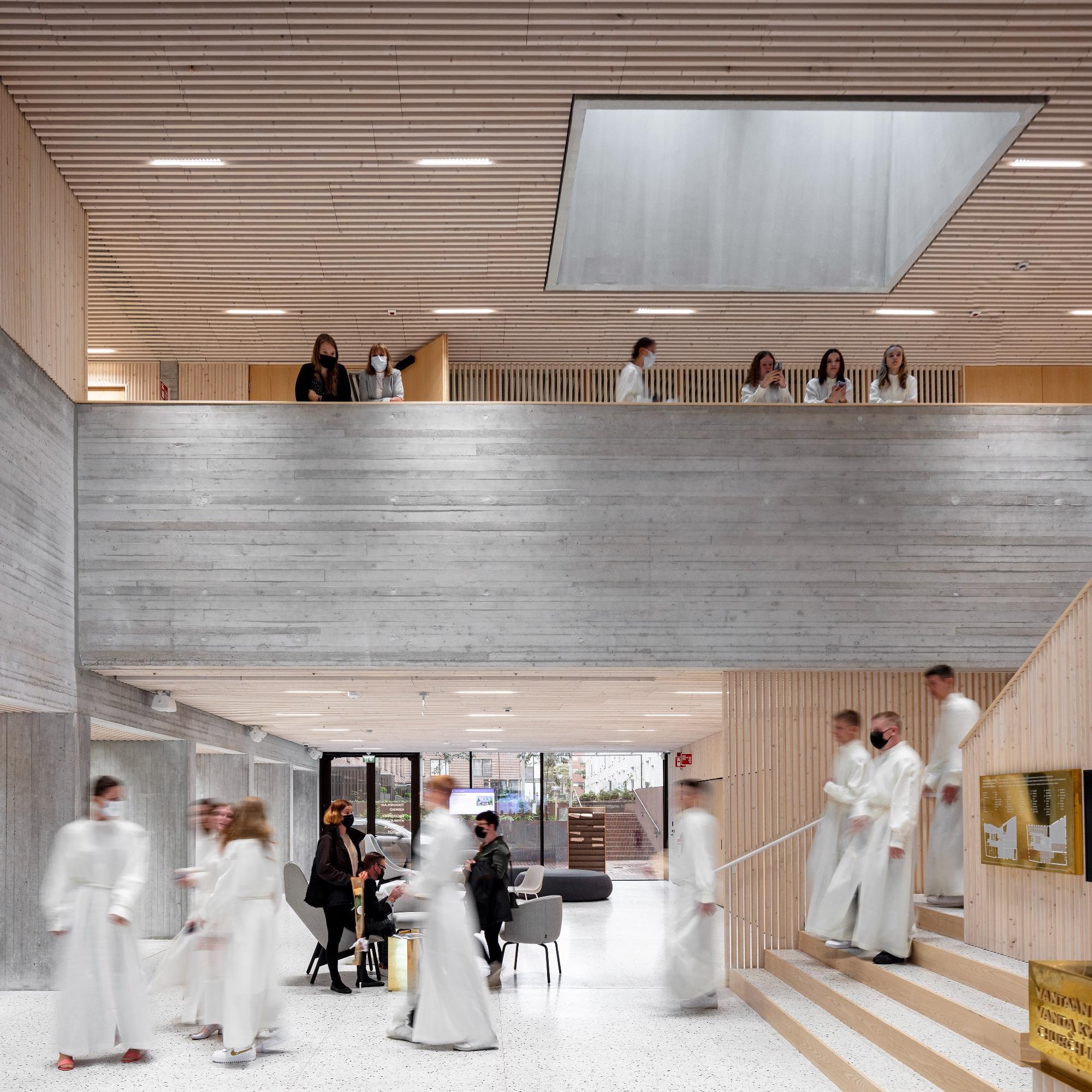
Image Credit: Marc Goodwin
Do you think you have achieved this with the Tikkurila Church and Housing?
The building has now been in use for about a year (the church since January 2021 and the housing since the end of April 2021), and the area around the church in the square is still awaiting some work to be completed by the city after the new construction in the entire neighborhood has been completed.
Regardless of the construction and street work that is still undergoing in the area around the block, it seems that the building has been very well received both by the people working there as well as by the residents and the users of the spaces. The more informal gathering spaces like the kids’ corner and the café have given people a welcome opportunity to meet in small groups in a shared space with a low threshold even in pandemic times.
Due to the varying levels of restrictions on public gatherings during pandemic times, there have been some limitations on the use of the spaces for large-scale events. However, with the events that it has been possible to organize, the experiences have been positive.
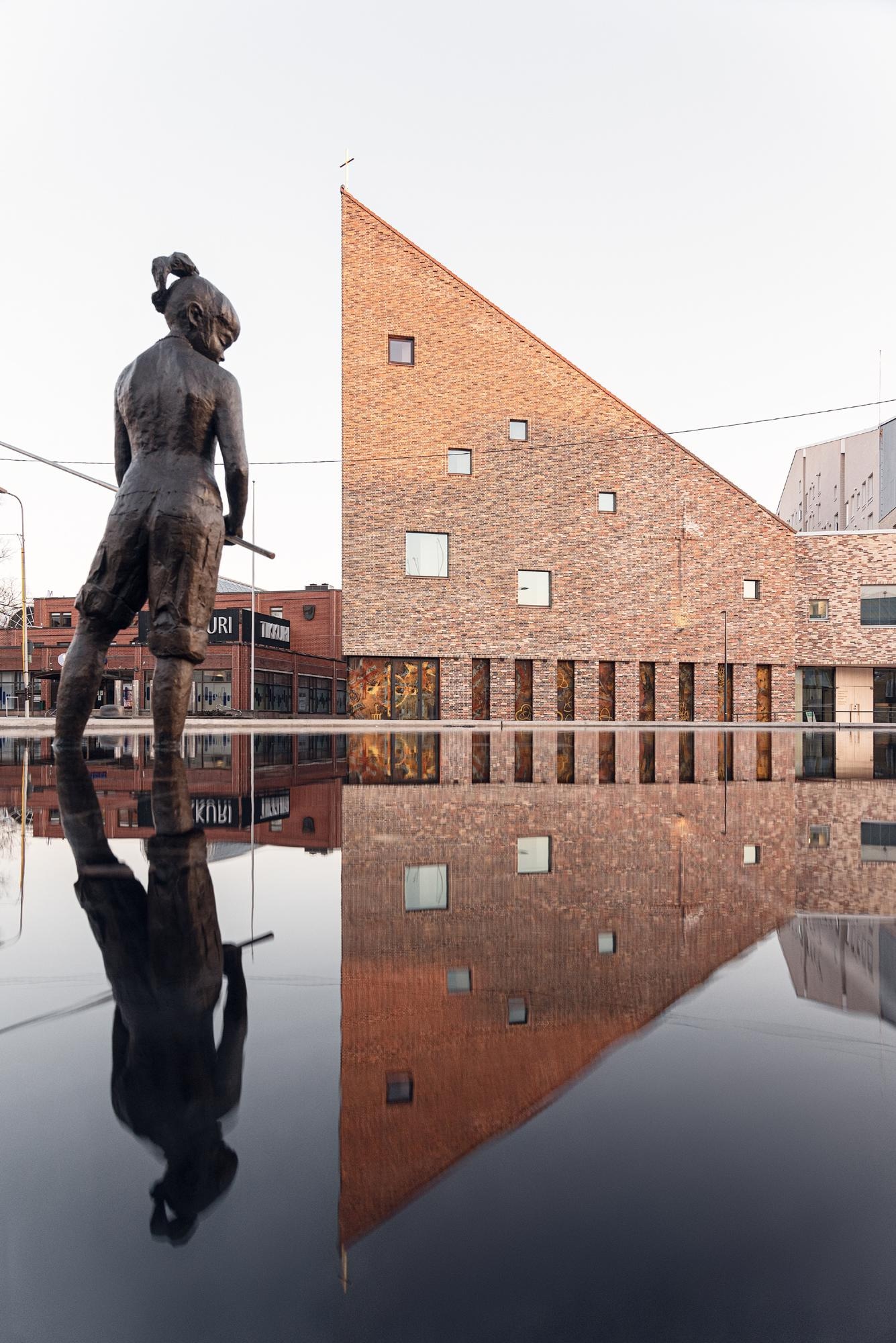
Image Credit: Hannu Rytky
The roofs of the building have green roofs and roof gardens; was this a sustainable or aesthetic choice for the building?
The roof gardens serve as shared spaces for the residents and employees to use. As shared spaces, they bring an element of semi-private spaces to the building and provide a place for informal gatherings. They also offer an opportunity for meeting people without necessarily planning ahead of time. In that way, they serve to support a sense of community among the residents.
Moreover, the green roofs create green views for the spaces above and have an esthetic function. They also form a protective surface on the roof covering underneath the green layer and help to support the longevity of it. In addition, the green surfaces serve to delay the drainage of the stormwater to better manage it.
The Tikkurila Church and Housing project has been shortlisted for the EU Prize for Contemporary Architecture – Mies van der Rohe Award. How does it feel to have your work nominated on this list?
The Tikkurila Church and Housing is not the first building by OOPEAA to be included in the shortlist for the Mies Award. Actually, the first project of mine to be shortlisted for the Mies Award was the Kärsämäki Church, and there have been several other ones since then. So, in that sense, it is not a new experience.

Image Credit: Hannu Rytky
However, it is always nice to see a building you have designed be recognized, and thereby also shared with a broader audience internationally. While buildings are naturally not designed with the goal of getting recognized with awards, spreading the word about sustainable architectural solutions in connection with the awards helps to promote the goal of creating buildings of high quality to provide a framework for a better life.
In that sense, I find that awards of high standards such as the European Union Mies van der Rohe Award for Contemporary Architecture serve a very important function.
Are there any other nominated architectural projects that you find exciting on the list this year?
This year there are many great examples of social housing of high standards included in the shortlist. I find this quite remarkable and inspiring. I see this as a signal that social housing is getting recognized as an important area in the larger field of architecture. In the past, it hasn’t been very common to consider buildings for social housing in shortlists for significant architecture awards that are not specifically focused on social housing.
There are also several very interesting buildings for culture and education included in the shortlist this year.
Community buildings and social housing dominate the nomination list this year; why do you think these types of spaces are attracting so much attention now?
These types of buildings serve a very important function in society. It seems that in recent years there has been a shift in focus in architecture away from a focus primarily on individual buildings that are unique in spectacular ways, to a broader perspective that includes buildings that serve an important functional purpose in people’s everyday lives.

Image Credit: Tuomas Uusheimo
Is OOPEAA working on any new architectural projects? Will there be a focus once more on community spaces or social housing?
We are currently working on several projects that relate to the themes of social housing and spaces for the community. Among them, there is a school in Järvenpää that will also serve as a civic center for the residents of the neighborhood and a new building complex in the center of Seinäjoki that will contain a new train station along with facilities for the regional health care services as well as housing.
With a strong focus on activating the neighborhood, the new building complex is part of the transformation of the central areas in the city to create a socially and ecologically sustainable urban environment. We have also been working actively on developing new modular solutions for urban housing based on wood, and there are several projects for blocks of wooden housing underway.
EU Mies Award Shortlist: einszueins architektur's Gleis 21
About Anssi Lassila
 Anssi Lassila is the founder and director of OOPEAA Office for Peripheral Architecture and Professor of Contemporary Architecture at the Oulu School of Architecture. His architecture combines a sculptural form with skillful handling of materials and innovative techniques. Placing the human being at the center, he has a keen interest in exploring the potential of wood as a sustainable solution and in developing new systems of flexibly customizable modularity.
Anssi Lassila is the founder and director of OOPEAA Office for Peripheral Architecture and Professor of Contemporary Architecture at the Oulu School of Architecture. His architecture combines a sculptural form with skillful handling of materials and innovative techniques. Placing the human being at the center, he has a keen interest in exploring the potential of wood as a sustainable solution and in developing new systems of flexibly customizable modularity.
His personal experience in working with wood extends from building with hand-carved logs to the use of CLT. His work has been recognized with some of the highest merits achievable both in Finland and internationally. OOPEAA works on a wide range of projects from churches and public buildings to housing and urban visions. The office is based in Seinäjoki and Helsinki, Finland.
Disclaimer: The views expressed here are those of the interviewee and do not necessarily represent the views of AZoM.com Limited (T/A) AZoNetwork, the owner and operator of this website. This disclaimer forms part of the Terms and Conditions of use of this website.